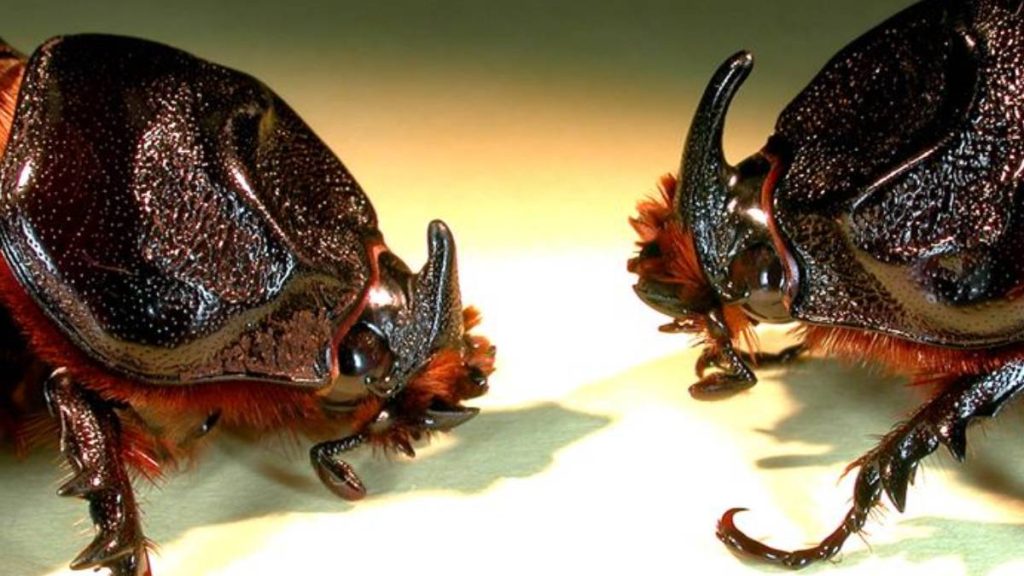Interim rule restricts movement of material that may contain coconut rhinoceros beetles

The Hawai‘i Department of Agriculture today established a new interim rule to help stop the movement of the coconut rhinoceros beetle from designated beetle-infested areas to non-infested areas in the state.
On Monday afternoon, the Advisory Committee on Plants and Animals recommended approval of an interim rule that restricts the movement of palm plants; decomposing plant material, such as compost, wood or tree chips; mulch; potting soil; and other landscaping products that may harbor coconut rhinoceros beetles, from infested areas to non-infested areas.
In addition, the new interim rule restricts the movement of palm plants higher than four feet in height, which will enable closer inspection of palm crowns where coconut rhinoceros beetles are most likely to bore into a tree. The new interim rule designates the island of O‘ahu as a coconut rhinoceros beetle-infested area. All other areas in the state are currently considered to be non-infested areas.
The interim rule was signed today by Hawai‘i Department of Agriculture Chairperson, Sharon Hurd, and is effective immediately. It is valid for one year, while Hawai‘i Department of Agriculture finalizes a permanent rule. The interim rule approved today is based on a previous interim rule established in July 2022, but expands restrictions on the movement of potential CRB host plants and plant materials, and increases the penalties.
Any individual, company or organization that violates the rule will be charged with a misdemeanor and fined not less than $100 and up to $10,000. Penalties for a second offense committed within five years will require the violator to pay for the cost of clean-up and decontamination fees to remove contaminated materials, and the cost to fully eradicate any coconut rhinoceros beetle infestations caused by the violation. Repeat violators will be fined not less than $500 and up to $25,000.
The new interim rule follows the first detection of coconut rhinoceros beetles on Maui three weeks ago, when a dead adult beetle was found in a bag of compost shipped from O‘ahu at a Maui retailer. No other coconut rhinoceros beetle has been detected on Maui. However, the efforts to restore the land and soil on Maui and Hawai‘i Island due to the wildfire damage have increased shipments of compost and organic landscaping material from O‘ahu, increasing the risk of the transport of coconut rhinoceros beetles to non-infested areas.
“The new interim rule will help our agricultural inspectors prevent the movement of coconut rhinoceros beetle and strengthens penalties for those who violate the rules,” said Hurd. “Preventing pathways of movement, and early detection is key to stopping the spread of these invasive beetles.”
Surveillance for coconut rhinoceros beetles has been ongoing on all neighbor islands, including pheromone traps at airports, harbors and other strategic locations. The traps are used for early detection of beetle infestations.
Green waste provides an optimal breeding environment for coconut rhinoceros beetles and residents on all islands are urged to check their compost bins and green waste for coconut rhinoceros beetle larvae and be aware of the visual signs of coconut rhinoceros beetle feeding damage on live palms.
Coconut rhinoceros beetles were first detected in Hawai‘i in December 2013 on O‘ahu and have gradually spread from Central and West O‘ahu to the North Shore and the windward side. In late May, coconut rhinoceros beetles were found on Kaua‘i and eradication efforts are ongoing.
Coconut rhinoceros beetles are a serious pest of palm trees, primarily coconut palms, as the adult beetles bore into the crowns of the palms to feed on the tree’s sap. New unopened fronds are damaged in this way and when fully opened, may break and fall unexpectedly. If the beetles kill or damage the growing point of the palm, the tree may die. Secondary fungal or bacterial pathogens may also attack the wounds caused by coconut rhinoceros beetles, thereby killing the tree as well. Tree mortality after coconut rhinoceros beetle attack has been reported to be anywhere from 10% to 50%. Dead trees then become a safety hazard as they may fall unexpectedly after the trunk rots, potentially resulting in bodily injury or property damage.
Coconut rhinoceros beetle is a major pest of palms in India, the Philippines, Palau, Fiji, Wallis, Nukunono, American and Western Samoa and Guam. It is still not known exactly how the beetles arrived in Hawai‘i.
Reports of possible CRB infestation may be addressed to the CRB Response Team at 808-679-5244 or email info@crbhawaii.org or the state’s toll-free Pest Hotline at 808-643-PEST (7378).



